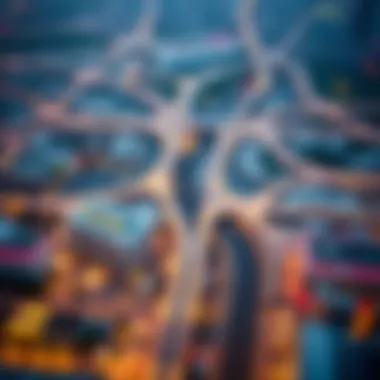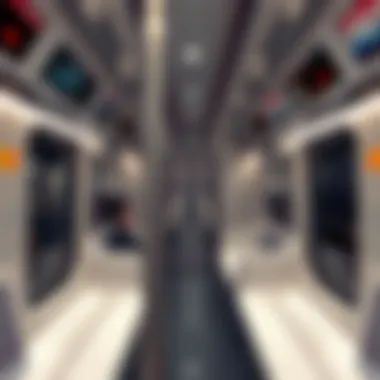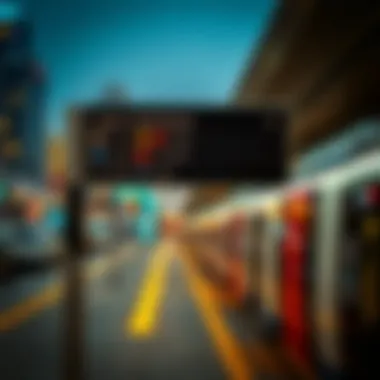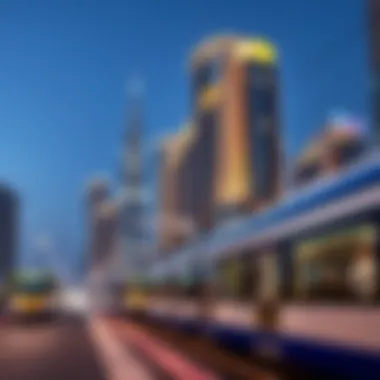Understanding the Metro Dubai Route and Real Estate Impact


Intro
Navigating the intricate web of the Metro Dubai system unwinds a treasure trove of opportunities for those looking to delve into the city's bustling real estate market. With each station serving as a landmark of potential investment, understanding how the metro’s efficient routes influence property values is crucial. As more residents and visitors flock to Dubai, the demand for housing grows, intertwining with metro accessibility to craft a narrative rich with possibilities.
The Dubai Metro doesn’t just transport people; it cultivates communities, enhances connectivity, and essentially plays a pivotal role in shaping the urban fabric. Real estate buyers, sellers, investors, and agents alike must grasp the nuances of how metro accessibility can elevate property desirability and, by extension, its market value.
Through this article, we aim to provide a comprehensive review of the current property market dynamics, and illuminate how the Metro Dubai system can dramatically impact neighborhoods and property trends. Let's dig into this urban transportation marvel and its ramifications on real estate.
Prelude to Metro Dubai
The introduction of the Metro in Dubai marks a significant advancement in urban transportation within the UAE's bustling economy. As the city continues to grow, efficient transit systems become paramount in managing the influx of people, goods, and services. To offer a clearer understanding of how this system functions and its broader implications, a thorough overview of Metro Dubai is necessary.
Overview of the Metro System
The Metro Dubai system consists of two main lines—the Red Line and the Green Line—covering extensive areas across the city. Launched in 2009, the Metro was developed as an eco-friendly alternative to road travel, aiming to alleviate traffic congestion and reduce carbon emissions. With its fully automated and driver-less trains, the system is not just a marvel of engineering but also a glimpse into the future of urban transit.
The Red Line stretches from Rashidiya to UAE Exchange, while the Green Line connects from Etisalat to Dubai Creek. This integration creates a cohesive framework that allows residents and visitors alike to traverse the city with ease. Furthermore, Metro Dubai operates on a 24-hour basis during weekends, reflecting its commitment to meet the demands of a cosmopolitan population. This accessibility has become a major selling point for both residents and businesses in the area.
Significance in Urban Mobility
When talking about urban mobility, Metro Dubai holds a pivotal role in transforming transportation patterns across the emirate. Public transport, especially a well-developed metro system, is crucial in promoting sustainable living. The convenience of the Metro encourages a shift from private vehicles to public transit, which can significantly cut back on road traffic and pollution levels.
Moreover, the Metro serves as a key enabler for urban development. Properties located near Metro stations often experience an increase in value—a sentiment echoed by most real estate agents and investors in Dubai. Accessibility to the Metro translates into a potential increase in foot traffic for businesses, enhanced property market attractiveness, and more opportunities for local economic growth. This integration of transport and urban planning promotes a multifunctional urban environment where people can live, work, and play with minimal stress.
Key Takeaway: The Metro system is not merely a means of transportation; it fundamentally reshapes how urban spaces are utilized, presenting significant implications for real estate investment.
In mapping the future trajectory of both Metro Dubai and the urban milieu, understanding these nuances is vital for investors, buyers, and developers alike. As we delve deeper into this exploration, we will unpack other essential aspects of the Metro, laying the groundwork for informed decisions in the vibrant Dubai real estate landscape.
Key Routes of Metro Dubai
Navigating the extensive Metro Dubai system is pivotal for both residents and visitors alike, impacting both urban mobility and real estate dynamics. This section delves into the key routes that form the backbone of the metro network, providing not only essential transport links across the bustling city but also influencing property values in close proximity to stations. Understanding these routes allows potential investors and commuters to maximize their travel experiences while making informed decisions regarding real estate ventures.
Red Line Overview
The Red Line of the Metro Dubai is arguably the spine of the city's public transport system, stretching approximately 52 kilometers from Rashidiya to UAE Exchange. This line links major areas, including the bustling downtown, business hubs, and iconic tourist attractions.
One key feature of the Red Line is its direct access to the Dubai International Airport, allowing travelers easy transit to and from flights without the hassle of traffic congestion. The line boasts numerous stations, each strategically placed to serve critical areas:
- Burj Khalifa/Dubai Mall: A popular stop for tourists, it provides access to the world's tallest building and one of the largest shopping centers.
- Dubai Marina: Home to a buzzing nightlife and restaurants, this station connects passengers to the vibrant coastal living of the emirate.
- Business Bay: A major business district where companies thrive, enhancing accessibility for corporate professionals.
Investors should take particular note of station proximity, as real estate situated within easy reach of the Red Line tends to hold a higher value and appeals greatly to both renters and buyers.
Green Line Overview
Parallel to the Red Line is the Green Line, a vital route running from Etisalat to Dubai Creek, encompassing 22.5 kilometers. The stations along the Green Line primarily serve the older parts of the city, rich in culture and history, thus attracting a different demographic. Some notable stations include:
- Al Fahidi: Located near the historic Al Bastakiya district, this area appeals to those keen on Dubai's heritage.
- Dubai Healthcare City: This stop is a hub for medical and health services, making it essential for residents accessing healthcare.
- Al Jaddaf: An emerging residential area that connects to upcoming developments along the creek.
This line is significant for property buyers looking to invest in more traditional neighborhoods while also leveraging transportation options to amenities that cater to daily lives.
Future Expansion Plans
Dubai has ambitious plans for further expanding its metro network. Authorities have green-lit projects aimed at enhancing connectivity not just within the city but also to neighboring emirates. Among the proposed additions:
- Route 2020: This extension of the Red Line will connect to the Expo 2020 site, aiming to increase traffic flow to the exhibition area, expected to draw millions.
- New Stations: There are plans for additional stations that will serve underdeveloped areas, encouraging future residential growth.
- Integrating with Rail Services: Future expansions may include connections to high-speed railway networks, facilitating longer-distance travel for both business and leisure.


The planned expansions contribute to the overall attractiveness of investing in real estate near these anticipated metro routes, making foresighted investments now a strategic move for potential quicker appreciation as new stations become operational.
In essence, the Red and Green Lines of Metro Dubai cater to diverse commuting needs, providing crucial transport links while also shaping the city's real estate landscape. As the metro system evolves, understanding these key routes remains significant for anyone involved in Dubai’s vibrant property market.
Metro Stations: A Closer Look
The backbone of the Metro Dubai system is its stations, each serving as a hub of activity and connectivity. Understanding these stations is crucial not only for passengers but also for investors and real estate enthusiasts. The strategic location of metro stations directly impacts nearby property values, enhancing accessibility and transportation options within the bustling city. The integration of metro stations in urban planning showcases forward-thinking that caters to both present and future needs, ensuring that the metro remains an essential component of Dubai's infrastructure.
Major Stations on the Red Line
The Red Line is often seen as the spine of the Dubai Metro network. Key stations such as Burj Khalifa/Dubai Mall attract both tourists and residents, linking them to a premier shopping destination. The area surrounding this station is ripe for rental opportunities, with properties boasting breathtaking views and proximity to the most iconic landmarks in Dubai.
In addition to Burj Khalifa, Deira City Centre serves as another pivotal station on the Red Line. It provides easy access to an impressive retail complex and is surrounded by residential developments that have shown increasing value since metro operations began. With commercial establishments thriving nearby, this location remains attractive to families and young professionals alike. Investors eyeing properties in this vicinity have noted a consistent uptick in demand and rental prices, underscoring the influence of public transport on real estate decisions.
Moreover, Dubai Marina station reflects an upscale lifestyle that caters to expatriates and tourists. Access to expansive waterfront views, restaurants, and leisure activities contribute to this station’s appeal. Properties close to this station can command premium prices, making it a hotspot for those seeking luxury living arrangements.
Notable Stations on the Green Line
Conversely, the Green Line plays a significant role in connecting less commercialized areas with bustling districts. Notable stations like Al Fahidi, rich in culture and history, are adjacent to heritage sites and shorter commuting times can enhance the appeal of surrounding properties to investors looking to capitalize on Dubai's dynamic real estate market.
Another noteworthy station is Emirates Towers, strategically placed near key business centers. Companies flock here due to the ease of transportation, which in turn boosts demand for commercial and residential real estate. Properties vying for attention in these areas may yield strong rental prospects due to the influx of professionals seeking efficient commute options.
Ultimately, the Green Line’s evolution encourages a broader approach to urban development, attracting diverse populations eager to reside in well-connected neighborhoods that cater to their daily needs.
Integration with Other Transport Modes
The true beauty of the Metro Dubai system lies in its integration with other transport modes. Metro stations seamlessly link with bus services and tram lines, extending the network’s reach across the city. For instance, the interchange at Union Station is where many commuters transfer easily between the Red and Green Lines or jump on a bus to reach their final destinations.
Such transfers are essential for those living in more remote areas, greatly expanding housing options for families and professionals working in downtown Dubai. Accessible transport leads to an increase in property values in suburban areas as more individuals consider them viable living spaces.
For tourists, connections to the Dubai International Airport metro station allow for a convenient transition from flights to city exploration. This attracts investors to surrounding neighborhoods as they gain popularity among travelers seeking accommodations near the airport, thereby diversifying their investment portfolios.
In summary, metro stations embody the pulse of urban mobility in Dubai. Their proximity and accessibility not only enhance the daily lives of commuters but also serve as a beacon for investors, encouraging thoughtful recommendations on where to buy real estate amidst a thriving metropolitan landscape.
The Impact of Metro Dubai on Real Estate
The construction of the Metro Dubai system has been nothing short of transformative for the real estate landscape in the city. As a vital cog in the urban fabric, it not only enhances commuting but also acts as a significant determinant for property values. Understanding the effects of the Metro on real estate is essential for investors, developers, and buyers alike; it gives insight into where to invest, what areas are growing, and how accessibility can change market dynamics.
Accessibility and Property Values
Metro Dubai provides unmatched accessibility to various neighborhoods, making it an attractive feature for potential homeowners and renters. Properties situated near metro stations often command higher prices due to ease of commute. For instance, a two-bedroom apartment in Al Barsha can fetch several thousand dirhams more than its counterpart located further away from a Metro stop.
Key factors contributing to property value increments include:
- Convenience: Easy access to public transport allows residents to save time.
- Increased Demand: High foot traffic near stations can lead to a surge in demand for both residential and commercial properties.
- Development Potential: Areas around metro stations often see new developments, raising the attractiveness of the locality.
As proximity to the Metro is a coveted trait, property buyers are now more inclined to consider metro accessibility as a primary criterion, increasing competition among prospective owners.
Trends in Nearby Developments
The areas surrounding Metro stations are experiencing a growth spurt in development and construction. This rise in development can be attributed to the obvious advantages that come with metro accessibility. Numerous neighborhoods are being redefined thanks to urban planning initiatives, often focusing on creating mixed-use developments. For instance, in neighborhoods like Dubai Marina and Downtown, the government and private enterprises are investing heavily to build lifestyle precincts that integrate residential, commercial, and recreational spaces in proximity to the Metro.
Emerging development trends include:
- Mixed-Use Projects: These cater to residents' work, leisure, and daily needs within a walkable distance, promoting urban living.
- Shopping Malls and Retail Units: New shopping centers are popping up near metro stations, drawing more foot traffic and contributing to local economies.
- Green Spaces: Developers are increasingly considering parks and open spaces to enhance the living experience.


With these development trends, areas adjacent to the Metro are undergoing rapid transformation that is sure to affect long-term property values positively.
Investor Insights: Metro Proximity as a Factor
For real estate investors, recognizing the Metro's impact is vital. Investors often look for opportunities in areas with strong potential growth, and the Metro system serves as a vital signpost. In Dubai, properties close to Metro stations are seen as safer investments because they usually appreciate in value.
Moreover, understanding local transport networks, including where expansion lines may go, can provide an edge to investors looking to make informed decisions.
Considerations for investors include:
- Market Demand: Properties near transit hubs will likely experience a steady influx of tenants and buyers.
- Long-Term Viability: The ongoing developments suggest sustained interest in the regions surrounding metro lines, contributing to long-term growth.
- Potential Risks: While there are clear upsides, investors must remain cautious about oversaturation in some areas due to extensive developments.
"Investing near a metro station may often yield a better return on investment due to the consistent demand for accessible living spaces."
In closing, the relationship between Metro Dubai and real estate goes beyond logistics; it shapes lives and defines city living. Investors and developers need to keep tabs on how the Metro influences their decisions, making it a cornerstone of any strategic real estate investment in Dubai.
Convenience and User Experience
In today's fast-paced world, where time is of the essence and convenience often reigns supreme, the user experience on public transportation systems like Metro Dubai becomes a paramount consideration. For investors and potential residents, an efficient transport system can significantly improve the livability scores of neighborhoods. The Metro Dubai not only enhances ease of movement but also shapes the overall perception of accessibility within the thriving metropolis.
User-Friendly Features of Metro Dubai
One of the hallmarks distinguishing Metro Dubai is its collection of user-friendly features designed with rider comfort in mind.
- Smart Ticketing System: The Nol Card, a smart payment card, simplifies the process of boarding and fare payment. Riders can effortlessly tap in and out, making the boarding process smooth and rapid.
- Digital Signage: Information displays track real-time arrivals and departures. This helps passengers plan their journeys better and reduces anxiety around missing a train.
- Accessibility Options: The Metro has made significant strides in creating an inclusive environment. Escalators, elevators, designated seating, and tactile guide paths cater to individuals with mobility impairments, ensuring ease of access for all.
These features collectively contribute to a seamless commuting experience, ensuring that riders can navigate the system without hassle.
Navigation Options and Tools
Navigating Metro Dubai is not just about getting on and off the train. It's about leveraging the available tools to ensure every journey is fluid and productive.
- Mobile Applications: The RTA app allows users to check schedules, plan routes, and even purchase fares on-the-go. This app is a lifesaver, effectively putting the entire transit system right at riders' fingertips.
- Online Journey Planners: Websites provide interactive maps and schematics that can greatly assist in route planning. The clear visualization removes uncertainty, particularly for newcomers to the metro system.
- Informative Guides: Printed maps and guide signs inside stations offer detailed information, enabling riders to familiarize themselves with the layout. They can check out connections with other transport modes effectively.
These resources help riders maximize their travel efficiency, empowering them to make informed decisions on their trips across the city.
Safety and Regulations
Safety is foundational when it comes to public transport systems, and Metro Dubai does not skimp in this area. Adhering to robust safety frameworks instills confidence among the users, further encouraging the use of the metro.
- Surveillance Systems: Throughout stations and trains, there are extensive surveillance cameras and security personnel to ensure passenger safety at all times. This detailed monitoring offers an extra layer of reassurance for commuters.
- Regulatory Compliance: The system operates under stringent regulations concerning safety, environmental impact, and maintenance standards. These measures aim to ensure that the infrastructure remains resilient and reliable.
- Emergency Protocols: Well-publicized emergency procedures educate passengers on how to react in various situations. Knowing there are procedures in place can soothe anxiety and provide a sense of safety, especially in unfamiliar systems.
By prioritizing safety and well-structured regulations, Metro Dubai fosters an atmosphere where commuters can ride with peace of mind.
"Public transportation is not just about getting from one place to another; it’s a vital network that connects people to opportunities and enhances overall urban life."
With such an array of convenient features and a strong focus on user experience, the Metro Dubai stands out as a prime asset in the landscape of urban mobility. Its comprehensive systems not only facilitate easy navigation but also nurture a safe and user-centric atmosphere, integral to both everyday travelers and future investors eyeing this booming city.
Environmental Considerations
The environmental aspects of the Metro Dubai system cannot be overlooked, especially given Dubai's rapid urban growth and development. The metro is not just a mode of transportation; it acts as a backbone for sustainable urban living. The design and implementation of the metro aim to minimize ecological impact while enhancing mobility, showcasing a model that other cities could aspire to replicate.
One of the key benefits of the Metro Dubai is its role in reducing traffic congestion. With a growing population, the reliance on personal vehicles has skyrocketed. In turn, this has led to increased emissions and environmental degradation. By encouraging the use of public transport, Metro Dubai significantly alleviates some of these pressures. Shifting a sizable segment of commuters from cars to the metro not only leads to lower pollution levels but also improves air quality in the city.
Sustainability Initiatives in Metro Operations


Metro Dubai is a pioneer when it comes to integrating sustainability into its operations. Various initiatives are in place to ensure that the metro system is environmentally friendly.
- Energy-efficient trains: The trains are designed to consume less energy. Advanced regenerative braking systems allow trains to recover energy during braking and use it efficiently.
- Solar energy utilization: Some stations are equipped with solar panels, which provide energy for lighting and other operational needs. This reflects an emphasis on harnessing renewable resources to power the metro system.
- Waste management practices: Stations are designed to manage waste sustainably. Initiatives include recycling programs and the separation of waste types to facilitate composting and material recovery.
"A transformational approach to urban transport should focus not only on mobility but also on sustainability and enhancing living conditions."
Additionally, water conservation features are employed. For instance, intelligent irrigation systems in station gardens minimize water usage while maintaining green spaces. These sustainable practices contribute significantly to Dubai’s broader vision of becoming one of the most environmentally friendly cities.
Carbon Footprint Reduction
Reducing the carbon footprint is paramount to addressing climate change. The Metro Dubai has put numerous measures in place to tackle this issue directly. The switch to electric trains marks a significant departure from traditional diesel-powered transit, favoring a cleaner energy source. This transition plays a vital role in lowering greenhouse gas emissions.
- Partnerships for clean technology: Metro Dubai collaborates with various organizations to develop innovative green technologies. These partnerships foster research and initiatives aimed at further reducing environmental impact.
- Carbon offset programs: Efforts are underway to invest in carbon offset initiatives. By contributing to projects that aim to reduce carbon emissions elsewhere, Metro Dubai can balance its operational carbon output.
In terms of statistics, it's estimated that every metro passenger journey contributes to substantial reductions in carbon emissions when compared to car travel. This collective transformation has a ripple effect, ultimately supporting the city’s environmental goals and contributing to global sustainability efforts.
Challenges and Criticisms
Understanding the challenges and criticisms surrounding Metro Dubai is fundamental for anyone invested in its impact on urban mobility and property values. While the system presents numerous advantages such as convenience and connectivity, it has also faced various operational and public challenges. Addressing these issues is crucial for potential investors, users, and urban planners, as the perception and functionality of the metro can significantly influence real estate opportunities in the surrounding areas.
Operational Hurdles
Despite being one of the most advanced metro systems in the world, Metro Dubai hasn't been free of its operational hurdles. One significant issue has been the reliability of service. Instances of delays, especially during peak hours, can frustrate daily commuters who rely on the metro for timely transportation. Factors such as maintenance work and system upgrades often contribute to unexpected disruptions.
Additionally, the logistics of maintaining an extensive transit network in a rapidly growing city like Dubai presents challenges. The absence of complete redundancy in the system means that when one line faces issues, it can lead to cascading delays across the network, straining the entire system. There's also the matter of older infrastructure needing updates to keep pace with increasing ridership. Regular assessments and upgrades are needed to prevent breakages that may lead to service interruptions, which can be costly—not just in revenue but also in public trust.
Furthermore, the initial costs for both passengers and operating bodies remain substantial. Fare increases have been a point of contention among residents, particularly for those who feel the rising costs do not match the quality of service provided.
Public Sentiment and Feedback
The public's sentiment regarding Metro Dubai has shifted over the years. While many commuters initially embraced the convenience of the metro, ongoing operational challenges have led to mixed feelings. According to surveys conducted on various platforms including reddit.com, respondents often express a sense of frustration regarding overcrowding, particularly during rush hours.
Moreover, some voice concerns over safety, although the metro is generally considered secure. Critiques often stem from high-profile incidents or perceived lapses in security within the stations, which can instill a level of apprehension among potential users.
An often-overlooked aspect is how public feedback can shape the future of the metro system. The Dubai Road and Transport Authority (RTA) frequently gathers user input to improve services, addressing complaints and suggestions that may stem from a lack of information about the system or its operational timings. In this sense, the residents’ feedback becomes invaluable in refining user experience.
"Public sentiment not only highlights the pressing issues within the metro system but also serves as a guiding beacon for improvements that may usher in a more reliable urban transit environment."
In summary, the challenges and criticisms of Metro Dubai—ranging from operational issues to public feedback—are not merely points of contention; they are areas ripe for development. As the city continues to expand, understanding these aspects will be essential for fostering a metro system that meets the needs of a diverse and growing population, while simultaneously impacting the real estate landscape significantly.
The End
The conclusion of any article offers a chance to reflect on the significance of the preceding content and its wider implications. Here, we contemplate the role of Metro Dubai as a cornerstone of urban mobility, addressing not just transportation, but also the burgeoning real estate landscape influenced by this key infrastructure.
The Future of Metro Dubai
As the city of Dubai propels itself further into the 21st century, the Metro system is expected to grow alongside it. Plans are in the works to expand its reach, incorporating more neighborhoods and possibly connecting to the upcoming mega-projects, fueling the ambition to accommodate an increasing population. A well-connected metro is not just about efficiency; it embodies the spirit of Dubai, a city built on innovation and modernization.
Investors should keep an eye on these developments. With every new station, there's a potential surge in property value, particularly in areas that were once considered remote. Moreover, the potential for enhancing accessibility to commercial hubs means that businesses will likely gravitate towards these locations, further escalating demand and, in turn, property prices. Future expansions will thus not only enhance journeys but also be pivotal for those looking to plant their roots in Dubai's vibrant soil.
Final Thoughts on Real Estate Implications
The intertwining of the Metro Dubai system and the real estate market paints a vivid picture for stakeholders. Understanding this connection is crucial for not only buyers and sellers but also for investors and developers who are navigating this dynamic terrain.
When considering a property purchase, proximity to the metro line can significantly influence the investment's long-term viability. A property located near a station can appreciate faster, reflecting the importance of strategic location and connectivity in urban settings. Buyers should also keep in mind the potential for higher rental yields in areas serviced by the metro, especially as Dubai continues to position itself as a global city attracting expatriates and tourists alike.
In summary, Metro Dubai is not just an efficient way to traverse the city; it is a critical player in shaping the locale’s socioeconomic landscape. Awareness of how this transport system affects real estate allows for more informed decision-making, maximizing value for every stakeholder involved.
"A well-connected city is a thriving city. The Metro isn't just about getting from A to B; it's about unlocking the potential of Dubai and its people."
Together, these insights form a cohesive understanding of why the Metro system remains an essential pillar in Dubai's ever-evolving narrative.











